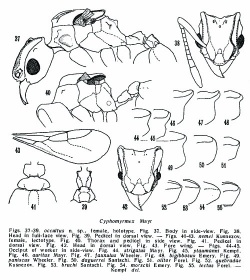Mycetophylax nemei
| Mycetophylax nemei | |
|---|---|

| |
| Scientific classification | |
| Kingdom: | Animalia |
| Phylum: | Arthropoda |
| Class: | Insecta |
| Order: | Hymenoptera |
| Family: | Formicidae |
| Subfamily: | Myrmicinae |
| Tribe: | Attini |
| Genus: | Mycetophylax |
| Species: | M. nemei |
| Binomial name | |
| Mycetophylax nemei (Kusnezov, 1957) | |
The holotype, the only known worker, has presumably been lost.
Identification
See description below.
Distribution
Latitudinal Distribution Pattern
Latitudinal Range: -36.366667° to -36.366667°.
| North Temperate |
North Subtropical |
Tropical | South Subtropical |
South Temperate |
- Source: AntMaps
Distribution based on Regional Taxon Lists
Neotropical Region: Argentina (type locality).
Distribution based on AntMaps
Distribution based on AntWeb specimens
Check data from AntWeb
Countries Occupied
| Number of countries occupied by this species based on AntWiki Regional Taxon Lists. In general, fewer countries occupied indicates a narrower range, while more countries indicates a more widespread species. |

|
Estimated Abundance
| Relative abundance based on number of AntMaps records per species (this species within the purple bar). Fewer records (to the left) indicates a less abundant/encountered species while more records (to the right) indicates more abundant/encountered species. |

|
Biology
|
Castes
Images from AntWeb

| |
| Paratype of Cyphomyrmex nemei. Male (alate). Specimen code casent0911148. Photographer Will Ericson, uploaded by California Academy of Sciences. | Owned by MHNG, Geneva, Switzerland. |
Nomenclature
The following information is derived from Barry Bolton's Online Catalogue of the Ants of the World.
- nemei. Cyphomyrmex nemei Kusnezov, 1957b: 7 (w.q.m.) ARGENTINA.
- Combination in Mycetophylax: Sosa-Calvo et al., 2017: 9.
- See also: Kempf, 1964d: 39.
Description
Kempf (1964) - Since the only known worker of the present species has been collected separately and is to all appearances lost, I select the above diagnosed female as the lectotype. The differential characters for the worker have already been pointed out in the preceding description. The female differs from that of quebradae (previously synonymized with Mycetophylax olitor) in the following characters: frontal lobes not evenly rounded, but forming a blunt angle, converging cephalad in front of angle, straight and slightly impressed. Epinotal teeth extremely feeble. Tergum I of gaster with the deeply impressed sagittal furrow on anterior half, traversed by rugosities. The frontal carinae are as in the olitor types, and do not possess distinctive value. It is quite possible that Mycetophylax nemei will eventually end up as synonym of olitor, unless we find another way of dealing with the striking variability of the latter species.
Worker
Kempf (1964) - According to the original description, this caste resembles rather closely that of quebradae (= Mycetophylax olitor), differing principally in the lack of a pronotal tubercle, in the laterally immarginate and discally convex mesonotum that lacks the two pairs of tubercles, in the unarmed epinotum that has a very short basal face, in the postero-dorsal contours of the postpetiole, which is less sinuous.
It seems even closer to Mycetophylax lectus from which it is separated by the following differences: frontal lobes less expanded, not covering part of the eyes in full-face view; inferior pronotal spine not drawn out; mesonotum as described above; petiole nearly twice as broad as long with conspicuously convex sides; postpetiole more than twice as broad as long, similar to that of "quebradae"; pilosity on tergum of gaster curved and subappressed,
Queen
Kempf (1964) - (lectotype) Total length 3.5 mm; head length 0.80 mm; head width 0.69 mm; thorax length 1.04 mm; hind femur length 0.75 mm. Light ferruginous; front and vertex darker. Integument opaque; sharply and finely reticulate-punctate, with sparser and larger punctures all over body and appendages; dorsum of head, scutum and scutellum, dorsum of gaster with superimposed reticula of coarser and intertwined rugulae, predominantly longitudinal on front and vertex and on tergum I of gaster.
Head (fig 42). Mandibles with 9 teeth. Frontal lobes converging cephalad, lateral borders straight to feebly impressed. Occipital lobes slightly prominent and set off. Thorax (fig 40), midpronotal tubercle absent, lateral ones low but distinct and subconical. Scutellum bluntly bidentate behind, a shallow excision between the teeth. Epinotal teeth weak, basal face of epinotum scarcely distinct from declivous face. Femora carinate and narrowly crested on flexor face, hind femora forming ventrally an angle on basal third, with a low foliaceous crest projecting from posterior border of femora on angle. Fore wing as shown in Fig. 43. Pedicel shown in Figs. 40 and 41. Postpetiole unusually broad as in bruchi and "quebradae", with a middorsal longitudinal shallow impression, and postero-laterally more deeply impressed. Tergum I of gaster anteriorly marginate, anterior half with a broad and deeply impressed longitudinal furrow, which is traversed by a series of irregular rugulae. Pilosity rather fine, curved and subappressed, subdecumbent on gular face of head and sternum of gaster.
Male
Type Material
Kempf (1964) - 8 females and 107 males, taken in nuptial flight on February 17, 1953, in the subtropical forest of the valley Soco Hondo, Reserva Nacional Estancia El Rey, Salta Province, Argentina; a lone worker taken separately at the same locality. The types in the Miguel Lillo Museum are either mislaid or lost except for a slide containing 2 males and 2 females. 8 males and 1 female (lectotype) in my collection (WWK).
References
- Kempf, W. W. 1964d. A revision of the Neotropical fungus-growing ants of the genus Cyphomyrmex Mayr. Part I: Group of strigatus Mayr (Hym., Formicidae). Stud. Entomol. 7: 1-44 (page 39, see also)
- Kusnezov, N. 1957e. Nuevas especies de hormigas (Hymenoptera, Formicidae). Rev. Soc. Urug. Entomol. 2: 7-18 (page 7, worker, queen, male described)
- Sosa-Calvo, J., JesÏovnik, A., Vasconcelos, H.L., Bacci, M. Jr., Schultz, T.R. 2017. Rediscovery of the enigmatic fungus-farming ant "Mycetosoritis" asper Mayr (Hymenoptera: Formicidae): Implications for taxonomy, phylogeny, and the evolution of agriculture in ants. PLoS ONE 12: e0176498 (DOI 10.1371/journal.pone.0176498).


